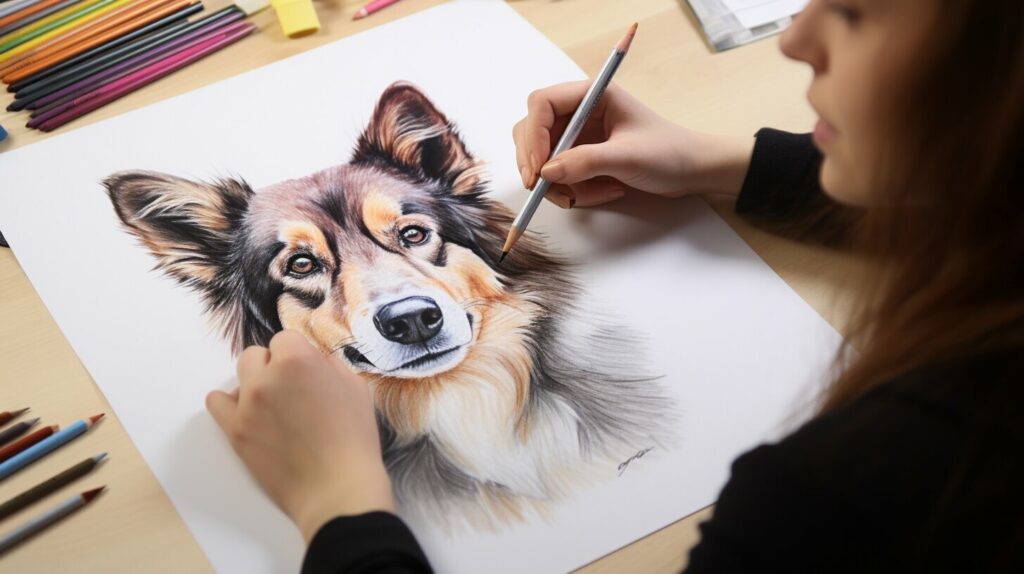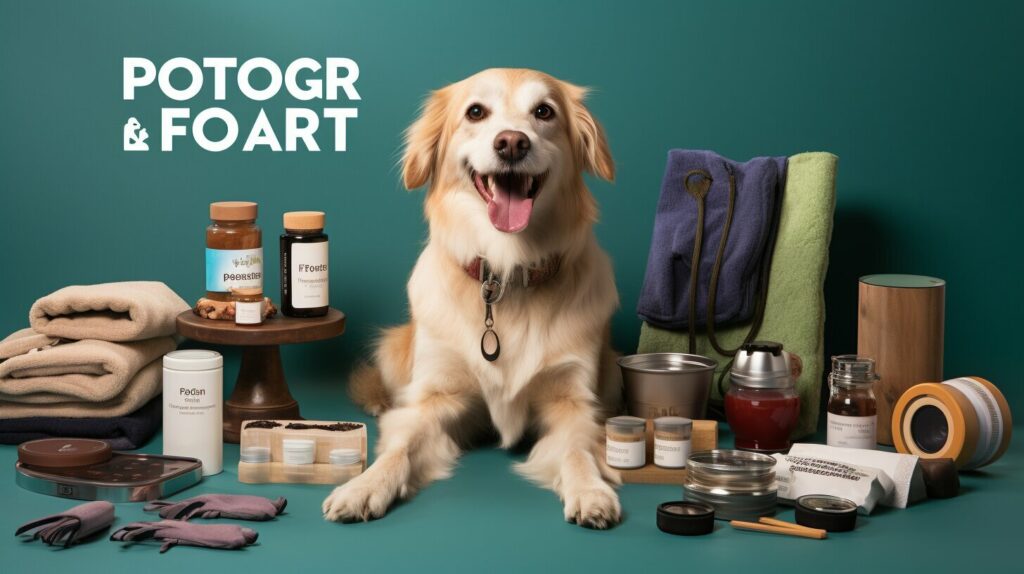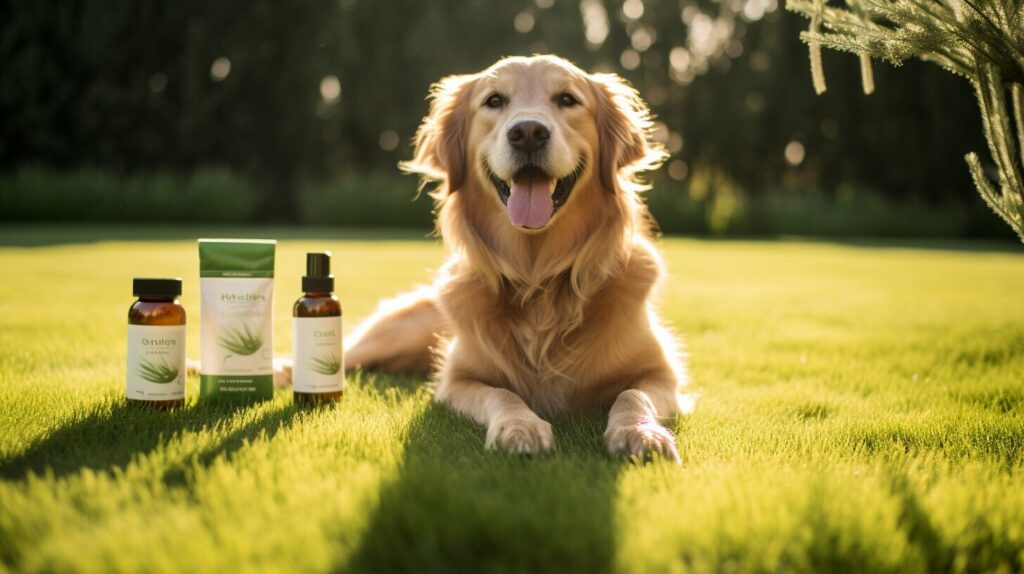Are you interested in learning to draw dogs? Whether you’re a beginner or an experienced artist, the Drawn Dogs Guide can help you enhance your art skills with step-by-step instructions, tips, and techniques for creating lifelike, expressive dog illustrations.
Dog illustrations and drawings are popular in the art world, and for good reason! Dogs are beloved pets and companions, full of personality and unique expressions. Learning to capture their essence in art can be both rewarding and challenging.
Key Takeaways:
- The Drawn Dogs Guide can help enhance your art skills with step-by-step instructions, tips, and techniques for creating lifelike, expressive dog illustrations.
- Dog illustrations and drawings are popular in the art world because dogs are beloved pets and companions, full of personality and unique expressions.
Getting Started with Dog Sketching
Learning to sketch dogs can be a fun and rewarding experience, whether you’re interested in creating realistic dog art or whimsical pet artwork. The key to success is to start with the basics, mastering the fundamental dog sketching techniques before moving on to more advanced styles.
Tips for Realistic Dog Art
For those interested in creating realistic dog art, it’s important to start by observing dogs closely and understanding their anatomy. Take time to study the proportions of a dog’s head, body, and limbs, and practice sketching these shapes until you feel comfortable with them.
When sketching, pay close attention to the details that make each dog unique, such as the shape of its ears and the texture of its fur. To add depth and realism to your sketches, use shading techniques to create highlights and shadows, emphasizing the form and structure of the dog’s body.
Creating Pet Artwork
For those interested in more whimsical or artistic dog sketches, there are many different styles to explore. Cartoon dog sketches can be a fun and playful way to capture a dog’s personality, while hand-drawn dog portraits can be a beautiful way to immortalize a beloved pet.
When creating pet artwork, remember to have fun and experiment with different styles and techniques. Don’t be afraid to add personal touches or incorporate unique elements into your sketches to make them truly one-of-a-kind.
Mastering Dog Sketching Techniques
Regardless of the style you choose, there are certain dog sketching techniques that are essential for success. These include understanding perspective, using the right materials, and having a steady hand when sketching.
Practice is key when it comes to mastering dog sketching techniques, so don’t be discouraged if your initial sketches don’t turn out exactly as you’d hoped. Keep practicing, experimenting with different styles and techniques, and don’t be afraid to ask for feedback from other artists or pet owners.
With time and dedication, you’ll be able to create beautiful dog sketches that capture the essence of man’s best friend and bring joy to those who see them.
Exploring Different Styles of Dog Drawings
Whether you prefer realistic dog portraits or artistic dog doodles, there’s no shortage of styles to try when it comes to drawing dogs. Here are some examples to inspire your next project:
Cartoon Dog Sketches
Cartoon-style dog sketches are playful and whimsical, often featuring exaggerated features and simplified shapes. To create your own cartoon dog, start by sketching the basic shapes and then adding in features like floppy ears and big eyes. Don’t be afraid to play with proportions and add in some fun details!
Hand-drawn Dog Portraits
A more realistic style, hand-drawn dog portraits capture the unique features and expressions of individual dogs. To create a lifelike portrait, start by observing the dog’s facial features and body shape. Use shading and highlights to add depth and realism to the fur and eyes.
Artistic Dog Doodles
For a more abstract approach, try creating artistic dog doodles. This style often involves using loose, expressive lines to capture the essence of a dog’s personality and movement. Experiment with different textures and patterns to create a unique and dynamic illustration.
Tools and Materials for Dog Sketching
Before you begin your dog sketches, it’s important to have the right tools and materials on hand. Here’s a list of essential supplies to get you started:
| Item | Recommendation |
|---|---|
| Pencils | Invest in a range of graphite pencils, from hard (4H) to soft (6B), to achieve different shades and textures in your sketches. |
| Erasers | A high-quality eraser is essential for removing mistakes and refining details. A kneaded eraser is great for lifting graphite off the paper without leaving residue, while a vinyl eraser can remove heavier markings. |
| Sketchbook | A dedicated sketchbook for your dog drawings will help you keep your artwork organized and easily accessible. Choose a size that’s convenient for you to carry around, like 9×12 inches or 11×14 inches. |
| Reference Materials | To create accurate and realistic sketches, it’s important to have reference materials on hand. These can include photographs of dogs in various poses and angles, anatomy books, or even your own pet as a model. |
These basic supplies are all you need to get started with your dog sketches. As you progress, you may want to experiment with other tools and materials, like charcoal, blending stumps, or toned paper.
Remember, the key to successful dog sketches is practice and experimentation. Don’t be afraid to try different techniques and materials to discover what works best for you.
Capturing Expressions and Emotions in Dog Portraits
As you continue to develop your drawn dogs skills, it’s important to focus on capturing the unique expressions and emotions of dogs in your portraits. A lifelike dog drawing not only accurately depicts physical characteristics but also conveys the personality and mood of the subject.
Start by observing the facial features and body language of the dog you’re drawing. Notice the shape and positioning of the eyes, ears, nose, and mouth, and how they convey different emotions. Pay attention to the position and movement of the body, as well as the positioning of the paws.
Shading is also crucial when it comes to capturing expressions and emotions. Use highlights and shadows to add depth and dimension to the dog’s face and body, emphasizing the contours and defining the features. Consider the direction of the light source and how it affects the shadows.
When working on a realistic dog portrait, it’s essential to pay attention to the small details, such as wrinkles, fur texture, and whiskers. These details can add a sense of realism and personality to the drawing.
As you continue to practice and improve your drawn dogs skills, don’t be afraid to experiment with different styles and techniques. Whether you prefer a more realistic approach or a more artistic and whimsical style, there’s no right or wrong way to capture the expressions and emotions of dogs in your pet artwork.
Step-by-Step Guide for Drawing a Lifelike Dog
If you’re ready to take your dog sketching skills to the next level, follow these step-by-step instructions to draw a lifelike dog:
- Start by sketching the basic shapes of the dog’s head and body. Use light lines to map out the proportions and position of the dog.
- Add details to the sketch, such as the dog’s facial features and ears. Observe the shape and size of each feature and adjust your sketch accordingly.
- Sketch the dog’s fur, paying attention to its texture and direction. Use delicate, short strokes to add texture to the fur and create a realistic look.
- Start shading the dog’s fur by using a darker pencil to add depth and dimension. Pay attention to where the shadow falls and how it interacts with the light source in your drawing.
- Continue layering the shading until you’re happy with the overall look of your drawing. Use a blending tool to smooth out the shading and create a seamless transition between light and shadow areas.
- If you’re feeling confident, you can add color to your dog sketch using colored pencils or other materials. Keep in mind the color of the dog’s fur and use shading to create depth and texture.
- Finally, step back and admire your lifelike dog drawing! Don’t be afraid to make adjustments or start over if you’re not happy with the result. Remember, practice makes perfect!
By following these steps and experimenting with different dog breeds and poses, you’ll be on your way to creating stunning dog drawings that capture the essence of man’s best friend.
Enhancing Your Dog Illustrations with Color
Adding color is a great way to bring your hand-drawn dog portraits or artistic dog doodles to life. There are various techniques to add color to your pet artwork, such as using colored pencils, watercolors, or digital tools. Here are some tips to enhance your dog illustrations with color:
Choose Your Color Palette Carefully
Before starting, choose a color palette that compliments your dog’s coat color and environment. Take note of the fur color, highlights, and shadows. If you’re using reference photos, observe the lighting to help you choose the right color palette.
Layer Colored Pencils for Depth and Texture
If you’re using colored pencils, layer them to create depth and texture in the fur. Start with light colors and use light pressure, gradually building up to darker colors with heavier pressure. Use a blending tool such as a blending stump or cotton swab to blend the colors together.
Experiment with Watercolors
Watercolors can provide a soft and delicate touch to your dog artwork. Wet your brush before dipping it in the color and experiment with different brush strokes, blending techniques, and layering colors. Use a dry brush to create texture in the fur.
Create Texture with a Dry Brush Technique
If you’re using watercolors or acrylics, try using a dry brush technique to create texture in the fur. Dip your brush in paint and blot it on a paper towel until it’s almost dry. Then, use quick, short strokes to create texture in the fur. This technique can also be used to create a background texture.
With these tips, you can enhance your dog illustrations with color and create unique pet artwork that stands out. Experiment with different techniques and color palettes to find what works best for you and your style.
Showcasing Your Dog Artwork
Now that you have created stunning dog illustrations, it’s time to showcase your artwork to the world. There are several ways to share your pet artwork and gain recognition for your skills.
Social Media Platforms
Social media platforms such as Instagram, Facebook, and Twitter are great places to showcase your dog artwork. You can create a dedicated page or account to attract followers who appreciate beautiful pet artwork. Use relevant hashtags like #drawndogs, #dogillustrations, and #petartwork to make your posts discoverable by others interested in dog artwork.
Art Galleries
Many art galleries and exhibitions feature animal-themed artwork, including dog illustrations and portraits. You can submit your artwork to these galleries for consideration or participate in art competitions to gain more recognition. Attend local art events and network with other artists to learn about upcoming opportunities.
Online Print-on-Demand Services
You can also sell your dog artwork on print-on-demand services like Society6 and Redbubble. These platforms allow you to upload your artwork, and they take care of the printing, packaging, and shipping. You can earn a profit from every sale made on their platform.
With these options at your disposal, you can showcase your dog artwork to a wide audience and develop a following for your unique style of pet artwork.
Tips for Overcoming Challenges in Dog Sketching
As an artist, you may face common challenges when sketching dogs. However, overcoming these challenges is essential to creating realistic dog art and improving your dog sketching techniques. Here are some practical tips to help you overcome these obstacles:
- Capturing fur texture: To achieve a realistic texture, observe the direction of the fur and use short, light pencil strokes to create depth. Use a reference image or real-life observation to ensure accuracy.
- Proportion errors: One of the most common mistakes when drawing dogs is proportion errors. To overcome this, start with basic shapes and focus on getting the proportions right before adding details. Use reference lines to help guide you.
- Achieving realistic shading: Shading is an essential element of creating realistic dog art. To achieve this, observe the light source and use a range of values to create depth and form. Practice blending and use a variety of pencils to achieve different levels of darkness.
Remember, practice and patience are key to improving your dog sketching techniques. Don’t get discouraged if it takes several attempts to achieve the desired result. Keep practicing and experimenting with different techniques, and soon you’ll be creating amazing dog illustrations and pet artwork.
Conclusion
In conclusion, the Drawn Dogs Guide offers many benefits for improving your art skills by focusing on our furry, four-legged friends. Dog illustrations and drawings have a special place in the art world, from realistic pet portraits to whimsical doodles.
By following the tips and techniques outlined in this guide, you can get started with dog sketching and explore different styles. Capturing the unique expressions and emotions of dogs in portraits is important, and shading and color can enhance the realism of your artwork.
Remember to practice and experiment with different materials and techniques to find what works best for you. Overcoming challenges, such as proportion errors and capturing fur texture, is part of the learning process.
Once you have created your dog artwork, there are many ways to showcase and share it with the world. Social media platforms, art galleries, and competitions are just a few options.
In summary, drawn dogs offer endless inspiration and possibilities for creating unique pet artwork. Keep practicing and expanding your skills, and who knows? You might just become the next great dog artist.
FAQ
Q: What is the Drawn Dogs Guide?
A: The Drawn Dogs Guide is a comprehensive resource designed to help individuals enhance their art skills specifically in drawing dogs. It provides tips, techniques, and step-by-step instructions to help you create realistic and artistic dog illustrations and drawings.
Q: Who is the Drawn Dogs Guide for?
A: The Drawn Dogs Guide is suitable for beginners who have little to no experience in drawing dogs, as well as more experienced artists looking to further develop their skills in dog sketching and illustration.
Q: What are the benefits of learning to draw dogs?
A: Learning to draw dogs can enhance your overall art skills and observation abilities. It allows you to capture the unique expressions and emotions of dogs, which can be a valuable skill for creating pet artwork, realistic dog portraits, or even cartoon dog sketches.
Q: Can I use different styles of dog drawings?
A: Absolutely! The Drawn Dogs Guide encourages experimentation with different styles of dog drawings. Whether you prefer realistic portraits, hand-drawn dog portraits, or artistic dog doodles, the guide provides tips and inspiration for creating dog illustrations in various styles.
Q: What tools and materials do I need for dog sketching?
A: To get started with dog sketching, you will need basic art supplies such as pencils, erasers, sketchbooks, and reference materials. The Drawn Dogs Guide provides a comprehensive list of recommended tools and materials, taking into consideration personal preferences and budget.
Q: How can I capture expressions and emotions in dog portraits?
A: Capturing expressions and emotions in dog portraits requires careful observation of facial features and body language. The Drawn Dogs Guide provides tips on how to observe and depict these details accurately, as well as techniques like shading and highlighting to bring depth and realism to your artwork.
Q: Is there a step-by-step guide for drawing a lifelike dog?
A: Yes, the Drawn Dogs Guide includes a step-by-step guide on how to draw a lifelike dog. It breaks down the process into manageable steps, starting with sketching the basic shapes and gradually adding details and shading to create a realistic rendition of a dog.
Q: How can I add color to my dog illustrations?
A: Adding color to dog illustrations can be approached using various techniques, such as colored pencils, watercolors, or digital tools. The Drawn Dogs Guide provides tips on color theory, blending, and creating texture in the fur of your dog artwork.
Q: How can I showcase my dog artwork?
A: The Drawn Dogs Guide offers suggestions on ways to showcase and share your dog artwork. It discusses social media platforms, art galleries, and competitions as avenues for displaying your work. Additionally, it provides tips on photographing or scanning your artwork for online sharing and printing.
Q: What tips can help me overcome challenges in dog sketching?
A: Dog sketching can present its own set of challenges, such as capturing fur texture, proportion errors, and realistic shading. The Drawn Dogs Guide addresses these challenges and offers practical tips and solutions to help you overcome them and improve your dog sketching skills.



